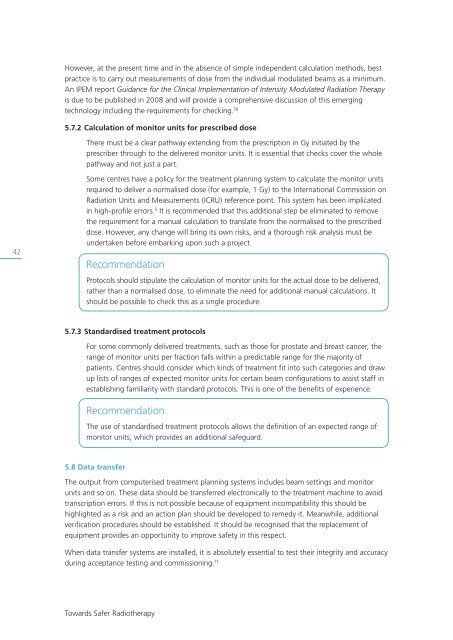Towards Safer Radiotherapy
Towards Safer Radiotherapy
Towards Safer Radiotherapy
You also want an ePaper? Increase the reach of your titles
YUMPU automatically turns print PDFs into web optimized ePapers that Google loves.
However, at the present time and in the absence of simple independent calculation methods, best<br />
practice is to carry out measurements of dose from the individual modulated beams as a minimum.<br />
An IPEM report Guidance for the Clinical Implementation of Intensity Modulated Radiation Therapy<br />
is due to be published in 2008 and will provide a comprehensive discussion of this emerging<br />
technology including the requirements for checking. 76<br />
5.7.2 Calculation of monitor units for prescribed dose<br />
There must be a clear pathway extending from the prescription in Gy initiated by the<br />
prescriber through to the delivered monitor units. It is essential that checks cover the whole<br />
pathway and not just a part.<br />
42<br />
Some centres have a policy for the treatment planning system to calculate the monitor units<br />
required to deliver a normalised dose (for example, 1 Gy) to the International Commission on<br />
Radiation Units and Measurements (ICRU) reference point. This system has been implicated<br />
in high-profile errors. 5 It is recommended that this additional step be eliminated to remove<br />
the requirement for a manual calculation to translate from the normalised to the prescribed<br />
dose. However, any change will bring its own risks, and a thorough risk analysis must be<br />
undertaken before embarking upon such a project.<br />
Recommendation<br />
Protocols should stipulate the calculation of monitor units for the actual dose to be delivered,<br />
rather than a normalised dose, to eliminate the need for additional manual calculations. It<br />
should be possible to check this as a single procedure.<br />
5.7.3 Standardised treatment protocols<br />
For some commonly delivered treatments, such as those for prostate and breast cancer, the<br />
range of monitor units per fraction falls within a predictable range for the majority of<br />
patients. Centres should consider which kinds of treatment fit into such categories and draw<br />
up lists of ranges of expected monitor units for certain beam configurations to assist staff in<br />
establishing familiarity with standard protocols. This is one of the benefits of experience.<br />
Recommendation<br />
The use of standardised treatment protocols allows the definition of an expected range of<br />
monitor units, which provides an additional safeguard.<br />
5.8 Data transfer<br />
The output from computerised treatment planning systems includes beam settings and monitor<br />
units and so on. These data should be transferred electronically to the treatment machine to avoid<br />
transcription errors. If this is not possible because of equipment incompatibility this should be<br />
highlighted as a risk and an action plan should be developed to remedy it. Meanwhile, additional<br />
verification procedures should be established. It should be recognised that the replacement of<br />
equipment provides an opportunity to improve safety in this respect.<br />
When data transfer systems are installed, it is absolutely essential to test their integrity and accuracy<br />
during acceptance testing and commissioning. 71<br />
<strong>Towards</strong> <strong>Safer</strong> <strong>Radiotherapy</strong>



